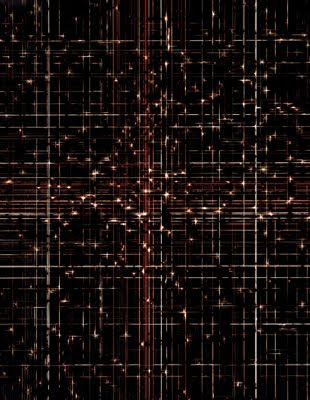top: detail from Marco Breuer’s Untitled (C-498), 2004, made with scratched chromogenic paper, courtesy Von Lintel Gallery , NY
bottom: detail, frames from Stan Brakhage hand scratched titles
This week we watched everybody's first attempts at hand scratched films --this was our first assignment in direct animation! It's a fun though laborious method of making your own titles and credits, like the venerable filmmaker Stan Brakhage (1933-2003) famous for his hand-scratched titles.
Directly working on the film and photographic material has been around as long as the materials themselves, but there's been renewed interest in direct techniques in the art world recently.
In 2008, The Drawing Center in New York -- which only shows drawings--had an amazing exhibit called DRAWING ON FILM that featured artists works from the 30's till the 00's. And check out the photographer Marco Breur whose most recent body of work finds him scratching directly onto exposed photographic paper, as above. Aperture published an awesome book of this work called 'Early Recordings '--we have it here in the Norlin Library .
Ok so here is John's scratch film--looks like he's all set with his end titles and all he has to do now is make the rest of his film!
Subscribe to:
Post Comments (Atom)


4 comments:
Thoughts on scratching on Film: Scratching and manipulating film is a very laborious task as each 16mm frame is going to be seen by the viewer whether they relies it or not. With 24 frames every second the process of writing text or detailed figures takes a steady and patient hand, but for some, like myself can be extremely therapeutic. There is something very special about allowing oneself to focus so intently on a minute frame where everything around seems almost non-existent. Whats even more magical is those tiny, nearly invisible scratches are transformed when played through a projector, creating rich textures as they are magnified. Not only do they add texture, but the scratches and shapes are brought to life, full of emotion and vigor as they dance around the screen.
Oskar Fischinger, an abstract animator, filmmaker and painter tried to find the relationship between our visual and audio senses. Studie No. 6
is the negative of charcoal on white paper. Fischingers work, although done in animation is very similar to our own scratch work as we attempt to get a sense of motion as one frame is followed by the next but never forgotten.
Check out my Blog for pictures and a description of my film shown above.
Enjoy :)
~John H
CU has opened my eyes to experimental film so much that after seeing "Avatar" I thought, "Well... I would've rather watched scratch films instead." Years of hard work and millions of dollars into that film to realize it was only as intriguing as its special effects. While a simple scratch upon emulsion seems to dance across the frame so endearingly.
I'm really enjoying the entire handmade process thus far, even if the end result doesn't necessarily show all the hard work that went into it.
Everyone's credits were really unique and I'm looking forward to the pieces that are going to develop throughout the semester.
I completely agree. I never realized how much intricate detail and time it takes to create a scratch film. It wasn't until I came to CU that I discovered scratching even existed. After taking the super 8 class last semester I was able to understand how difficult it actually is. Along with this, I was finally able to appreciate the brilliance of film as an art form. Films by Brakhage no longer bored me because I had tried scratching and knew the process artists such as Brakhage went through. I am so thrilled that I am in a film class that allows so much room for experimentation.
Post a Comment